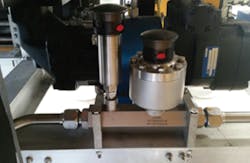Turbine Flowmeters Remain Competitive in Turbulent Market
Continued product improvements and a large installed base are helping the turbine flowmeter market hold its own in a turbulent market. According to Flow Research, turbine flowmeter revenues totaled $460 million in 2013 and are forecast to increase at a compound annual growth rate (CAGR) of 3.2 percent per year through 2018 to reach $538 million worldwide.
Suppliers report that some customers are choosing multipath ultrasonic meters over turbine meters due to less maintenance and non-intrusive designs. However, they also report that the higher price of ultrasonic meters and the high cost to calibrate them, combined with the uncertainty of their in-service accuracy and performance, is starting a trend back to proven turbine meter performance.
Turbine meter suppliers are making technology improvements to produce more reliable meters, many of which involve making the moving parts more reliable. By constructing bearings out of more durable material, such as ceramic or sapphire, turbine suppliers have been able to significantly extend bearing life. This is important, since some customers select new-technology meters over turbine meters because turbine meters have moving parts. Other recently introduced improvements include bidirectional flow, self-lubrication, and significantly reduced pressure drop. Additionally, dual-rotor designs offer improved accuracy and flow range, less pressure drop, and reduced flow swirl effects.
READ ALSO:
- Energy and Large-Pipe Applications Drive Coriolis Technology to New Heights
- Differential Pressure Maintains a Powerful Place in the World of Flow Measurement
- Magmeters Top the Flowmeter Market In Revenue
- PD Flowmeters Poised to Gain from Oil & Gas Application Opportunities
- Emissions Monitoring Applications Propel Thermal Flowmeter Market
- Custody-Transfer Applications Drive Ultrasonic Flowmeter Growth
- Vortex Flowmeters Prove Their Worth In Steam Flow Measurement
There are many reasons why turbine flowmeters remain popular. For example, turbine meters have a significant cost advantage over ultrasonic and Coriolis meters, especially in larger line sizes, although suppliers report increasing difficulty competing with ultrasonic and magnetic flowmeters in large line sizes. The price of turbine meters may also compare favorably to differential-pressure (DP) flowmeters, especially in cases where one turbine meter can replace several DP meters. And users who already have turbine meters and don’t want to pay the price of switching technologies are likely to stay with turbine meters.
Industry approvals are also helping to keep turbine meters competitive. Turbine meters enjoy approvals from the American Gas Association (AGA) and from the American Water Works Association (AWWA) for custody-transfer applications. In Europe, turbine flowmeters are approved by the International Standards Organization (ISO). All these approvals have helped turbine meters maintain their competitive position.
While the flowmeter market is turbulent in the sense that it is highly competitive with a constant influx of new products, the installed base for turbine meters, along with new product development, is helping turbine flowmeters thrive in many markets. Turbine meters for oil applications are widely used in trucking terminals for loading hydrocarbons into trucks, and for offloading them from trucks. They are also used in aviation applications, where they compete with positive-displacement and Coriolis flowmeters. Turbine meters are also used for in-plant measurement within refineries and chemical plants.
For more information on the turbine flowmeter market, visit www.flowturbine.com.
Jesse Yoder
Jesse Yoder, Ph.D., is president of Flow Research Inc. He has 30 years of experience as an analyst and writer in instrumentation. Yoder holds two U.S. patents on a dual-tube meter design and is the author of "The Tao of Measurement," published by ISA. He may be reached at [email protected]. Find more information on the latest study from Flow Research, "The World Market for Gas Flow Measurement, 4th Edition," at www.gasflows.com.



